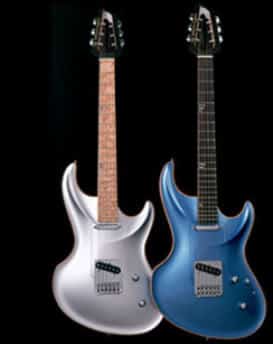 THE MIRAGE GUITAR WAS nurtured to fruition among the wine-growing valleys of California by MJ Guitar founder and owner Mark Johnson, whose exciting blend of vintage and space-age varieties was a formulated during the 22 years he spent building instruments for other manufacturers. In 1993, Johnson stepped out on his own and produced the first Mirage prototype, and by 1997 the company offered five different production models to its growing list of customers. These five models all share the same basic structure and art differentiated by their choice of wood and bridge/pickup layouts. Our review model is the Mirage GT ($2,695), which dons and the traditional layout of the Telecaster, with two single coils plus selector and master controls, and a fixed, low-profile bridge.
THE MIRAGE GUITAR WAS nurtured to fruition among the wine-growing valleys of California by MJ Guitar founder and owner Mark Johnson, whose exciting blend of vintage and space-age varieties was a formulated during the 22 years he spent building instruments for other manufacturers. In 1993, Johnson stepped out on his own and produced the first Mirage prototype, and by 1997 the company offered five different production models to its growing list of customers. These five models all share the same basic structure and art differentiated by their choice of wood and bridge/pickup layouts. Our review model is the Mirage GT ($2,695), which dons and the traditional layout of the Telecaster, with two single coils plus selector and master controls, and a fixed, low-profile bridge.
While the pickup/bridge layout may be familiar, little else about the GT seems to be from this planet. The extra-terrestrial body features a semi hollow poplar back (mahogany and alder are used on other models), capped by a deeply arched Western Maple top. This sleek lines of the sculpted body are exceptionally beautiful, especially the carved ridges that run down the center of each horn and flow into the top. This design appears even more fluid under the optional stunning metallic finish that changes from Emerald green to violet as the light strikes it. A deep chamber on the back to of the body creates a svelte joint for this set neck. Machined from a richly figured birds eye Maple, the well-proportioned neck provides a slinky journey from its 22nd fret down to the unusual head stock. This elegant structure is strengthened by a woven carbon fiber facing and an aluminum brace at the apex, both of which add to the futuristic styling. The result is a near straight string spread and easy access to the trust rod bolt.
Details seem to be the watchword at MJ Guitars, and the Mirage certainly bears up to scrutiny. The level of workmanship is very high: the glassy finish has been flawlessly applied to the complex curves, and the tricky, masked maple binding is surgically clean. The medium-size frets are well-seated and highly polished, and the mother-of-pearl bar inlays are a classy touch. Finally, the innovative pickup mounting deserves special praise: rather then split all the GT’s liquid contours with a pickguard, Johnson has mounted the pickups beneath a central plate that’s graded and finished to integrate seamlessly with the top. The body’s multiple curves must have made this feature a real head-scratcher, what an elegant solution.
Once plugged in, the Mirage did not disappoint. The Seymour Duncan Alnico Pro II pickups deliver fat Tele tone, beefed up and rounded out by the semi hollow body and set neck. Clean sounds are crisp and fruity without any harshness producing punchy twang from the bridge pickup and warm and woody tones at the neck. Stroke up the overdrive, and the GT shifts up a gear, delivering greasy boogie, sustaining blues and that tough Tele raunch that can over rock a humbucker. A surprising array of buxom tones can be easily pulled from the GT’s simple electrics, but if you have different recipe in mind, look no further than the comprehensive option menu. Want a GT with 24 frets, 30″ baritone neck and a B-Bender? You can have it, along with your choice of pickups, frets, finished and just about anything else, all for a reasonable charge.
BOTTOM LINE
So many companies offer to redesign the electric guitar for us, but it takes something very special to sway our loyalty to the traditional big names. Mr. Johnson has designed a superb instrument that could sway more then your loyalty with its intelligent balance of form and function. It plays great, sounds great and, in between, you can just enjoy looking at it.





Be the first to comment